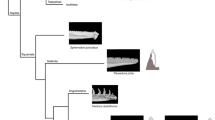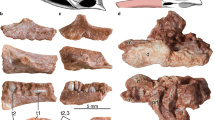Summary
As in all skarks, the ectoderm ofHeterodontus folds in behind the jaw cartilage during embryogenesis. The anterior part of this ectodermal fold becomes organized into the Inner Enamel Epithelium which cooperates with the mesenchyme. Already during the infolding, both tissues begin to form teeth. This process begins with a spontaneous division of the fold along its long axis into tooth-forming and non tooth-forming tissue sections. In this way the tooth formula of the “first dentition” is established. The Inner Enamel Epithelium and the mesenchyme only gradually attain competence for tooth formation, so that the first formed tooth germs become incomplete tooth shards (Fig. 8). Shortly before the end of the embryonic phase, as soon as the infolding stops, the tooth transport mechanism begins to work.Heterodontus hatches with a characteristic “first dentition”, which has a typical dental formula of 17to19/13to15.
Because of allometric growth, the number of tooth families increases strongly in the course of a lifetime, but to different degrees in the various species. The “first dentition” is composed of teeth having numerous needle-like cusps; it is only slightly heterodont and serves in feeding on soft-bodied benthonic animals. In the course of ontogeny, a highly heterodont dentition becomes differentiated. The anterior part of the adult dentition is composed of teeth with 1–3 cusps, while the distal part bears molariform teeth. On the basis of these distal teeth, two groups of species may be distinguished: a primitive group (Francisci-type) distributed in the Indopacific and having slender, keeled crushing teeth (probably specialized for a diet of echinoderms), and a group of species derived from it (Portusjacksoni-type) found only in the western Pacific and having broad, powerful crushing teeth capable of cracking hardshelled molluscs.
It is characteristic that the most distal tooth family of the first dentition becomes the main crushing tooth within the molariform group in the course of ontogeny. This tooth family lies at the point where the most force can be brought to bear by the jaw apparatus, and remains there life-long; that is, it does not change position relative to the jaw.
Since the infolded ectoderm lies on the inner side of the jaw, its growth is controlled by the growth of the jaw. The jaw on the Portusjacksoni-type grows forward sharply to form a beak so that the infolded ectoderm must grow forward with it and thus can form extra tooth families. The infolded ectoderm expands outwards in the course of ontogeny toward the distal ends of the rami. As soon as a gap appears between tooth primordia in this fold, it is filled by a new tooth germ whether the gap results from forward migration of an already-formed tooth or from elongation of the folded ectoderm during growth.
In theHeterodontus dentition there are two tooth-form gradients: On one hand, tooth-form in each family changes in the course of time; on the other, the dentition is heterodont at each ontogenetic stage. Thus, within each dentition there is a tooth form and tooth size gradient. Tooth form and size, therefore, are determined by two coordinate parameters:
-
1.
the age of the animal and
-
2.
the position in the dentition.
The observations on the dentition ofHeterodontus lead to the interpretation that the insertion of new teeth and tooth families, as well as their form and size, is regulated by a complex system of reference points which transmit positional information to the tooth-forming cells.
Similar content being viewed by others
References
Applegate, Sh.P.: Tooth terminology and variation in sharks with special reference to the sand shark,Carcharias taunts Rafinesque. Contr. Sci.86, 2–18, (1965)
Beaumont, G. de: Recherches sur la denture et la cavité orale d'Alopiasvulpinus Bonat. (Selachii). Rev. suisse Zool.66, 387–410 (1959)
Casier, E.M.:Constitution et évolution de la racine dentaire des Euselachii. Bull. Mus. Hist, nat, Belg.23 13, 1–15;23 (14), 1–32;23 (15), 1–45 (1947)
Casier, E.M.: Transformation des systèmes de fixation et de vasculatisation dentaires dans l'évolution des selaciens du sou ordre des squaliformes. Mem. Inst. r. Sci. nat. Belg.65, 1–60 (1961)
Compagno, L.J.V.: Systematics of the genusHemitriakis (Selachii, Carcharinidae) and related genera. Proc. Calif, Acad. Sci., 4. ser.38, 63–98 (1970)
Compagno, L.J.V.: Interrelationships of living elasmobranchs. In: Interrelationships of fishes, P.H. Greenwood, R.S. Miles, C. Patterson, eds. Zool. J. Linn. Soc.53, Suppl. 1, 15–61 (1973)
Dempster, R.P., Herald, E.S.: Notes on the hornshark,Heterodontus francisci, with observations on mating activities. Occ.Pap. Calif. Acad. Sci.33, 1–7 (1961)
Denision, R.H.: The structure and evolution of teeth in lungfishes. Fieldiana Geol.33, 31–58 (1974)
Edmund, A.G.: Tooth repkcement phenomena in the lower vertebrates. Roy. Ont. Mus. Life Sci. Dic., Contr.52, 1–190 (1960)
Feduccia, A., Slaughter, B.H.: Sexual dimorphism in Skates (Rajidae) and its possible role in differential niche utilization. Evolution28, 164–168 (1974)
Garman, S.: The Plagiostomia (Sharks, Skates, and Rays). Mem. Mus. Comp. Zool.36, 1–528 (1913)
Gudger, E.W.: Abnormal dentitions in sharks, Selachii. Bull. amer. Mus. nat. Hist.73, 249–280 (1937)
Hertwig, O.: Über Bau und Entwicklung der Placoidschuppen und der Zähne der Selachier. Jena. Z. Med. Naturw.8, (1974)
Hildebrand, M.: Analysis of vertebrate structure. New York-London-Sydney-Toronto: Wiley 1974
Jacobi, K.: Kiefergebiß und Zähne der Rochen und Haie. Marburg/Lahn: Elwert 1939
Kuhn, E.: Über Acrodus-Funde aus dem Grenzbitumenhorizont der anisischen Stufe der Trias des Monte San Giorgio (Kt. Tessin). Ecologae geol. Helv.38, 662–673 (1945)
Laaser, P.: Die Entwicklung der Zahnleiste bei den Selachiern. Anat. Anz.17, 479–489 (1900)
Laaser, P.: Die Zahnleiste und die ersten Zahnanl gen der Selachier. Jena. Z. Med. Naturwiss.37, 551–570 (1903)
Landolt, H.H.: Über den Zahnwechsel bei Selachiern. Rev. suisse Zool.54, 305–367 (1947)
De Mar, R.: Evolutionary implications of Zahnreihen, Evolution26, 435–450 (1972)
Marquard, E.: Beiträge zur Kenntnis des Selachiergebisses. Rev. suisse Zool.53, 73–132 (1946)
McEachran, J.D., Musick, J.A.: Characters for distinguishing between immature specimens of the sibEng species,Raja erinacea and Raja ocellata (Pisces: Rajidae). Copeia1973, 238–250 (1973)
McLaughlin, R.H.: The ecology of heterodont sharks. Ph.D.-Thesis, University of Sydney, N. S. W. (1969)
McLaughlin, R.H., O'Gower, A.K.: Underwater tagging of the Port-Jackson shark,Heterodontus portusjacksoni (Meyer). Bull. Jnst. Oceanogr.69 1410, 3–11 (1970)
McLaughlin, R.H., O'Gower, A.K.: Life history and underwater studies of a heterodont shark. Ecol. Monogr.41, 289–341 (1971)
Miles, A.E.W., Gaunt, W.A.: Fundamental aspects of tooth morphogenesis. In: Structural and chemical organization of teeth, A. E. W. Miles, ed., Vol. I, pp. 151–197. New York: Academic Press 1967)
Moss, S.A.: Tooth replacement in the lemon shark,Negaprion brevirostris. In: Sharks, skates, and rays, P.E. Gilbert, ed., pp. 319–329, Baltimore, Maryland: John Hopkins Press (1967)
Nelson, D.R., Johnson, R.H.: Diel activity rhythms in the nocturnal, bottom-dwelling sharks,Heterodontus francisci andCephaloscyllium ventriosum, Copeia1970, 732–739 (1970)
Nobiling, G.: Die Biomechanik des Kieferapparates beim Stierkopfhai (Heterodontus portusjacksoni=Heterodontus philippt). Dissertation, Universität Tübingen (1974)
Ørvig, T.: Acanthodian dentition and its bearing on the relationships of the group. Palaeontographica A143, 119–150 (1973)
Osborn, J.W.: New approach to Zahnreihen. Nature225, 343–346 (1970)
Osborn, J.W.: The evolution of dentitions. Amer. Scientist61, 548–559 (1973a)
Osborn, J.W.: On the biological improbability of Zahnreihen as embryological units. Evolution26, 601–607 (1973b)
Osborn, J.W.: On the control of tooth replacement in reptiles and its relationship to growth. J.theor.Biol.46, 509–527 (1974)
Preuschoft, H., Reif, W.-E., Müller, W. H.: Funktionsanpassungen von Haifisch-Zähnen in Form und Struktur. Z. Anat. Entwickl.-Gesch.143, 315–344 (1974)
Rauther, M.: Echte Fische, Teil 1. In: Bronn's Klassen und Ordnungen des Tierreiches, Bd. 6, Abt. I, Buch 2, Teil 1. Leipzig: Akademische Verlagsgesellschaft 1940
Reif, W.-E.: Revision ofHeterodontus bonae-spei Ogilby (1908) (Pisces, Selachü). Copeia1973, 155–176 (1973a)
Reif, W.-E.: Morphologie und Skulptur der Haifisch-Zahnkronen. N. Jb.Geol. PaläontAbh.143, 39–55 (1973b)
Reif, W.-E.: Morphologie und Ultrastruktur des Hai-„Schmelzes”. Zool.Scr.2, 231–250 (1973c)
Reif, W.-E.: Ontogenese des Hautskelettes von Heterodontusfalcifer (Selachü) aus dem Untertithon. Stuttgarter Beitr. Naturk. B, Nr. 7, 16 pp. (1973d)
Reif, W.-E.: Morphogenese und Musterbildung im Hautzähnchen-Skelettvon Heterodontus. Lethaia7, 25–42 (1974a)
Reif, W.-E.: Teeth and dermal denticles ofHeterodontus falcifer (Upper Jurassic) andHeterodontus japonicus (Recent). Summarizing Report. Scientific Report of the Keikyu Aburatsubo Marine Park Aquarium, No. 5, 6 (for 1973, 1974), pp. 16–20 (1974b)
Reif, W.-E.:Metopacanthus sp. (Holocephali) andPalaeospinax egertoni S. Woodward (Selachii) aus dem unteren Toarcium von Holzmaden. Stuttgarter Beiträge Naturk. B, No. 10, 9 pp. (1974c)
Schweizer, R.: Über die Zähnevon Heterodontus semirugosus (Plien.) aus dem Brenztaloolith von Schnaitheim und dem Diceraskalk von Kelheim (Malm Zeta). N. Jb. Geol. Paläont. Abh.113, 95–109 (1961)
Schweizer, R.: Die Elasmobranchier und Holocephalen aus den Nusplinger Plattenkalken. Palaeontographica A123, 58–110 (1964)
Smith, B.G.: The heterodontid sharks: their natural history, and the external development ofHeterodontus japonicus based on notes and drawings by Bashford Dean. In: The Bashford Dean Memorial Volume „Archaic Fishes”, E. W. Gudger, ed., pp. 649–673, Amer. Mus. nat. Hist. Publ. (1942)
Taniuchi, T.: Variation in the teeth of the sand shark,Odontaspis taunts (Rafinesque) taken from the East China Sea. Jap. J. Ichthyol.17, 37–44 (1970)
Taylor, L.: A revision of the shark family Heterodontidae. Dissertation, University of California, San Diego (1972)
Whitley, G.P.: The development of a Port-Jackson Shark. Proc. r. Zool. Soc. N.S.W.1950, 28 (1950)
Wolpert, L.: Positional information and pattern formation. In: Towards a theoretical biology, C.H. Waddington, ed., Vol. 3, pp. 198–230. Edinburgh: University Press 1970
Woodward, A. S.: Catalogue of the fossil fishes in the British Museum. Part 1: Elasmobranchii. London: British Museum 1889
Author information
Authors and Affiliations
Additional information
Konstruktions-Morphologie Nr. 50; Nr. 49 vgl. Netzel, H.: Arch. Protistenk.117, 219–245 (1975).
Rights and permissions
About this article
Cite this article
Reif, W.E. Morphogenesis, pattern formation and function of the dentition ofHeterodontus (Selachii). Zoomorphologie 83, 1–47 (1976). https://doi.org/10.1007/BF00995429
Received:
Issue Date:
DOI: https://doi.org/10.1007/BF00995429




